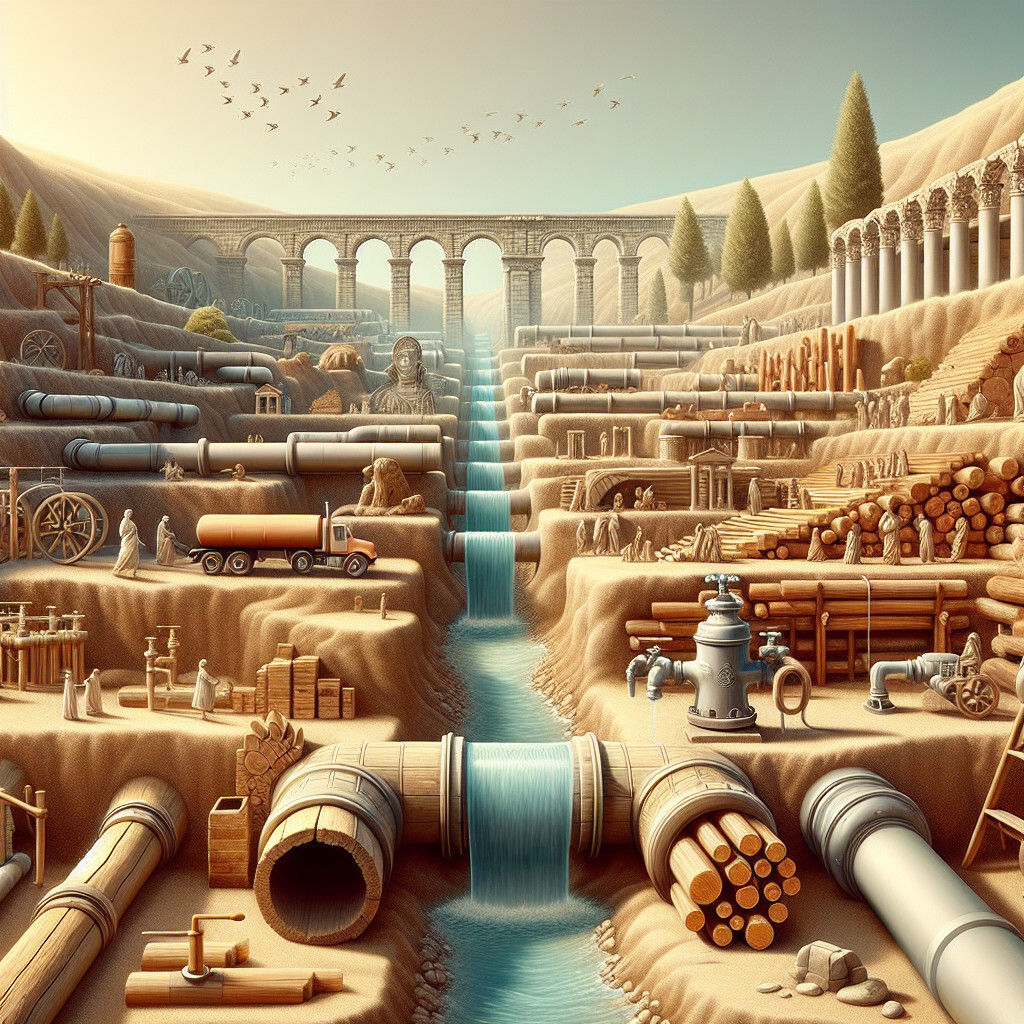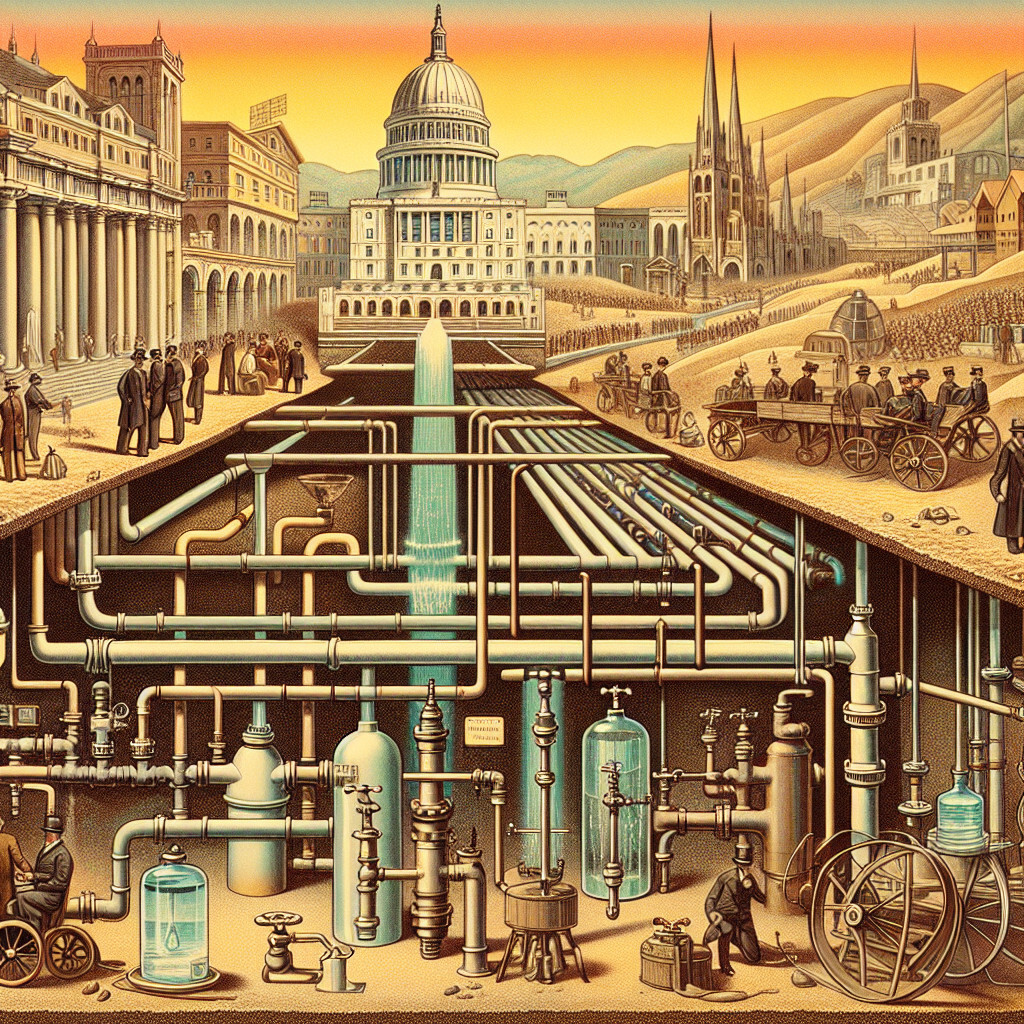-
Table of Contents
“Tracing the Flow: The Evolution of Tap Water Systems Through Time”
Introduction

The history of tap water systems dates back to ancient civilizations, where the need for clean, accessible water was a fundamental aspect of societal development. The earliest known water systems were in the Indus Valley civilization around 2600 B.C., where they built simple wells and sophisticated drainage systems. The Romans later revolutionized water systems by constructing aqueducts, bringing water from miles away into cities and towns. In the 19th century, the advent of modern plumbing and sanitation practices led to the development of municipal water systems, providing tap water to homes and businesses. The introduction of water treatment in the 20th century further improved the safety and quality of tap water. Today, tap water systems are a critical infrastructure, supplying clean water for drinking, cooking, and hygiene to billions of people worldwide.
Evolution of Tap Water Systems: A Historical Perspective
The history of tap water systems is a fascinating journey that reflects the evolution of human civilization, technological advancements, and public health awareness. The story of tap water systems begins in ancient times, where the earliest civilizations recognized the importance of clean water for survival and developed rudimentary systems to deliver it.
The ancient Romans were among the first to develop a complex system of aqueducts, pipes, and tunnels to transport water from distant sources to their cities. This was a remarkable feat of engineering for its time, and it laid the groundwork for the modern tap water systems we use today. The Roman aqueducts were not only a means of providing water for drinking and bathing but also a symbol of the power and sophistication of the Roman Empire.
However, with the fall of the Roman Empire, much of this knowledge and technology was lost. During the Middle Ages, people often relied on wells, springs, and rivers for their water supply, which was often contaminated and led to widespread disease. It wasn’t until the 19th century that the importance of clean, safe drinking water was fully recognized, and efforts were made to develop more advanced water supply systems.
The Industrial Revolution brought about significant advancements in technology and infrastructure, which greatly influenced the evolution of tap water systems. In the mid-19th century, London became the first city to introduce a comprehensive sewer system, which significantly improved public health by reducing the spread of waterborne diseases. Around the same time, the concept of water treatment was introduced. The process involved filtering the water and adding chlorine to kill bacteria and other harmful microorganisms, making the water safe to drink.
In the United States, the first municipal water treatment plant was established in 1872 in Poughkeepsie, New York. This marked a significant milestone in the history of tap water systems, as it demonstrated the feasibility and benefits of centralized water treatment. Over the next few decades, the concept of municipal water treatment spread across the country, leading to a dramatic improvement in public health.
The 20th century saw further advancements in water treatment technology, including the introduction of fluoridation to prevent tooth decay and the use of advanced filtration methods to remove harmful chemicals and pollutants. Today, tap water systems are highly sophisticated and regulated to ensure the safety and quality of the water supply.
However, despite these advancements, access to clean, safe drinking water remains a significant issue in many parts of the world. According to the World Health Organization, nearly 2 billion people worldwide do not have access to safely managed drinking water services. This highlights the ongoing challenges and the need for continued efforts to improve and expand tap water systems globally.
In conclusion, the history of tap water systems is a testament to human ingenuity and the relentless pursuit of progress. From the ancient Roman aqueducts to the sophisticated water treatment plants of today, each stage in the evolution of tap water systems has brought us closer to the goal of providing clean, safe drinking water for all. As we look to the future, we must continue to innovate and strive for solutions that ensure access to this vital resource for everyone, everywhere.
The Role of Infrastructure in Shaping Modern Tap Water Systems
The history of tap water systems is a fascinating journey that underscores the role of infrastructure in shaping modern societies. The evolution of these systems, from rudimentary aqueducts to sophisticated networks of pipes and treatment facilities, has been instrumental in fostering public health, economic growth, and urban development.
The story of tap water systems begins in ancient civilizations, where the need for clean, accessible water led to the construction of aqueducts. The Romans, for instance, built an extensive network of aqueducts to transport water from distant sources to their cities. These early systems were primarily gravity-fed, relying on the natural slope of the terrain to move water. While rudimentary by today’s standards, these aqueducts laid the groundwork for the development of more complex water infrastructure.
The Middle Ages saw the introduction of wells and cisterns, which provided a more localized solution for water access. However, these systems were often contaminated, leading to widespread disease. It wasn’t until the 19th century that the concept of water treatment emerged. The Industrial Revolution brought about significant advancements in technology and engineering, paving the way for the development of modern tap water systems.
In the 19th century, the advent of steam power and iron pipe manufacturing revolutionized water infrastructure. Cities began to construct centralized water systems, complete with pumping stations and distribution networks. These systems were capable of delivering large volumes of water over long distances, transforming the way cities were built and how people lived.
However, the water supplied through these systems was not always safe to drink. The realization of the link between contaminated water and disease outbreaks led to the introduction of water treatment processes. In the late 19th century, sand filtration and chlorination were introduced, significantly improving the quality of tap water. These advancements marked a turning point in public health, drastically reducing the incidence of waterborne diseases.
The 20th century saw further advancements in water treatment technology, with the introduction of processes like coagulation, flocculation, and activated carbon filtration. These processes allowed for the removal of even smaller particles and contaminants, further improving the safety and quality of tap water.
Today, modern tap water systems are a marvel of engineering and technology. They consist of intricate networks of pipes, pumps, and treatment facilities, capable of delivering clean, safe water to millions of people. These systems are a testament to the power of infrastructure in shaping societies, driving economic growth, and promoting public health.
However, despite these advancements, challenges remain. Aging infrastructure, climate change, and population growth are putting increasing pressure on tap water systems. Ensuring the sustainability and resilience of these systems is a critical challenge for the 21st century.
In conclusion, the history of tap water systems is a testament to human ingenuity and the transformative power of infrastructure. From the ancient aqueducts to the sophisticated water treatment facilities of today, these systems have played a pivotal role in shaping modern societies. As we look to the future, the continued evolution of tap water systems will be crucial in addressing the pressing challenges of our time.
From Wells to Faucets: The Transformation of Tap Water Systems
The history of tap water systems is a fascinating journey that traces the evolution of human civilization from its earliest days to the present. This transformation, from wells to faucets, is a testament to human ingenuity and the relentless pursuit of progress.
In the earliest days of human civilization, water was sourced directly from nature. Rivers, lakes, and rainwater were the primary sources of water for drinking, cooking, and bathing. As civilizations grew and developed, the need for a more reliable and convenient water source became apparent. This led to the creation of wells, which were essentially holes dug into the ground to access groundwater. Wells were a significant advancement in water systems as they provided a steady and reliable source of water, even during periods of drought.
The use of wells continued for centuries, with improvements made over time. The Romans, for example, developed a sophisticated system of aqueducts to transport water from wells and springs to cities and towns. This was a precursor to the modern tap water systems we have today. However, it was not until the 19th century that significant advancements in tap water systems were made.
The Industrial Revolution brought about a significant shift in the way water was sourced and distributed. With the advent of steam power and mechanization, it became possible to pump water from wells and reservoirs directly into homes and businesses. This marked the birth of the modern tap water system. However, these early systems were not without their problems. Water contamination was a significant issue, as there were no effective methods for treating and purifying the water.
The late 19th and early 20th centuries saw significant advancements in water treatment. The discovery of the germ theory of disease led to the realization that many illnesses were caused by contaminated water. This led to the development of water treatment processes, such as filtration and chlorination, which significantly improved the safety and quality of tap water.
The 20th century also saw the widespread adoption of tap water systems. With the growth of cities and the expansion of infrastructure, tap water became accessible to a large portion of the population. Today, tap water systems are a fundamental part of our daily lives, providing us with safe and clean water at the turn of a faucet.
However, despite these advancements, challenges remain. In many parts of the world, access to clean and safe tap water is still a significant issue. Aging infrastructure, pollution, and climate change are also posing threats to our tap water systems. As we move forward, it is crucial that we continue to innovate and improve our tap water systems to ensure that everyone has access to safe and clean water.
In conclusion, the transformation of tap water systems from wells to faucets is a remarkable journey that reflects the progress of human civilization. It is a story of innovation, progress, and the relentless pursuit of a better life. As we look to the future, we must continue to build on this legacy, ensuring that everyone, everywhere, has access to safe and clean tap water.
Innovations and Improvements: A Timeline of Tap Water Systems History
The history of tap water systems is a fascinating journey of innovation and improvement, reflecting the evolution of human civilization and its relentless pursuit of progress. From the rudimentary aqueducts of ancient Rome to the sophisticated water treatment facilities of the modern era, the development of tap water systems has been marked by a series of remarkable breakthroughs that have transformed the way we access and consume water.
The story of tap water systems begins in the ancient civilizations of Rome and Greece, where the first aqueducts were built. These impressive structures, some of which are still standing today, were designed to transport water from distant sources to urban centers. The water was then distributed to public fountains, baths, and even some private households, marking the first instance of a centralized water supply system.
The Middle Ages saw the decline of these systems, with water being sourced primarily from wells and rivers. However, the Renaissance period brought about a renewed interest in water supply systems, leading to the construction of more advanced aqueducts and the introduction of lead pipes for water distribution. This period also saw the advent of the first water treatment methods, such as sand filtration and boiling, which were used to purify water and make it safe for consumption.
The Industrial Revolution in the 19th century marked a significant turning point in the history of tap water systems. The rapid urbanization and population growth necessitated the development of more efficient water supply systems. This led to the invention of the steam-powered water pump, which greatly increased the capacity for water distribution. The first municipal water treatment plant was also established during this period, introducing the concept of chlorination to eliminate waterborne diseases.
The 20th century brought about further advancements in water treatment technology. The discovery of harmful chemicals and pollutants in water led to the development of more sophisticated treatment methods, such as activated carbon filtration and reverse osmosis. These technologies not only improved the quality of tap water but also made it possible to desalinate seawater, thereby increasing the availability of potable water.
In recent years, the focus has shifted towards sustainable and eco-friendly water supply systems. The advent of smart water networks, which use sensors and data analytics to monitor and manage water distribution, has made it possible to reduce water wastage and improve efficiency. Moreover, the growing awareness about the environmental impact of bottled water has led to a resurgence in the use of tap water, further underscoring the importance of reliable and safe water supply systems.
In conclusion, the history of tap water systems is a testament to human ingenuity and resilience. From the ancient aqueducts to the modern water treatment facilities, each innovation and improvement has been driven by the need to ensure access to clean and safe water. As we move forward, it is crucial to continue investing in research and development to further enhance the efficiency and sustainability of our tap water systems. After all, water is not just a basic human necessity; it is the lifeblood of our civilization.
Q&A
1. Question: When were the first tap water systems introduced?
Answer: The first tap water systems were introduced in ancient Rome around 312 BC, with the construction of aqueducts.
2. Question: What was the purpose of the first tap water systems?
Answer: The first tap water systems were designed to transport water from distant sources into cities and towns, providing a public water supply for drinking, bathing, and irrigation.
3. Question: How did tap water systems evolve in the modern era?
Answer: In the 19th century, with the advent of industrialization and urbanization, tap water systems evolved significantly. The introduction of sand filtration and chlorination greatly improved the safety and quality of tap water.
4. Question: What are some challenges faced by tap water systems today?
Answer: Today, tap water systems face challenges such as aging infrastructure, contamination from industrial pollutants and natural disasters, and ensuring access to clean and safe drinking water for all populations.
Conclusion
In conclusion, the history of tap water systems is a testament to human ingenuity and the evolution of public health measures. From the ancient civilizations who first engineered aqueducts and pipes, to the development of filtration and chlorination methods in the 19th and 20th centuries, tap water systems have continually advanced to ensure the delivery of safe and clean water. However, challenges remain in many parts of the world where access to clean tap water is still a major issue, indicating the need for ongoing efforts and innovations in this field.






